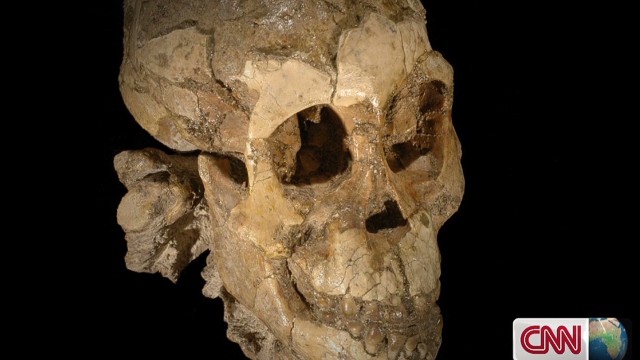(CNN) -- It was another December afternoon back in 2000, spent like hundreds of others combing the rocky hills of the Dikika region, when Ethiopian scientist Zeray Alemseged heard one of his assistants nearby calling him.
"He said 'oh, doctor I
see something there,'" recalls Alemseged, who'd been excavating the hot
and dry landscape for over a year, helped only by a small inexperienced
crew of locals. "And I went there and I see the cheek bone part ...
sticking out of the rock. I turned it upside down and my jaw literally
dropped."
Instantly, Alemseged realized this was an extraordinary discovery that could make scientific history.
"Right away I could tell
this is a child of a human ancestor," says the paleoanthropologist. "You
have this child in a block of sandstone, with the baby teeth still
visible, very vertical forehead, small canine," he adds. "But it's so
rare and so unbelievable that I just couldn't accept that was the case,
that what I saw was the skeleton."
Yet Alemseged did not
want to make news of his discovery public until he had a more complete
picture of what he'd unearthed. So he kept it quiet as he meticulously
prepared and analyzed the fossil.
"The skeleton was encaved
in a block of sandstone matrix, which is very densely compact, very
inured sand, so that I had to go remove the sand grain by grain," says
Alemseged.
"So I took my time, and
people advised me to employ technicians, and technicians can do that
job, but I said 'no, it's going to take as long as it takes but I'm not
going to delegate this work of the exploration of this unique child to
anyone else but me.'"
Alemseged then spent
years in the lab painstakingly picking away the sand grain by grain. By
using a super microscope, he was able to see details in the teeth
embedded in the skull that revealed to him the skeleton's age and the
sex. He now knew the fossil was that of a three-year-old girl who had
died 3.3 million years ago.
Finally, after more than
six long years, Alemseged was ready to present to the world "Selam,"
the fossil known as "the world's oldest child."
"When the time came to
go to the press conference," remembers Alemseged, "it was like a woman
is pregnant and she is holding that baby for nine months and when the
baby comes out, what happens is -- in spite of the pain, in spite of the
long, tedious process of carrying the baby -- you see her smiling, you
see her beautiful wonderful face trying to share the baby with her
husband or the doctor.
"So I shared my baby
with the audience but the different thing is that I was sharing a child
that belonged not only to me but to humanity, to seven billion
individuals."
My work is beyond nations, beyond nationalities, beyond continents -- it unites everyone on the planet.
Zeray Alemseged, Ethiopian paleoanthropologist
Zeray Alemseged, Ethiopian paleoanthropologist
That press conference in 2006 turned Alemseged, who was just 31 when he'd discovered Selam, into a hero in the world of science.
Over the next few years,
his work took him all over the world, winning him international
admiration for his achievements. Today Alemseged is the director of
anthropology at the California Academy of Sciences, a multifaceted
scientific institution and museum where he combines his scientific
research with his passion for public education.
"When I got involved in
this type of research I decided to not only read what has already been
discovered but also to make my own discoveries and I can proudly say
that I have achieved that with the discovery of Selam and many other
fossils," he says. "Those finds are finds that change textbooks,
literally, so I am happy but I'm not satisfied -- I will be satisfied
only if I could instill the same type of psychology, the same type of
excitement, the same type of passion to the next generations of
Africans."
Alemseged, a father of
two, enjoys the opportunity to share his findings with the world and
possibly inspire a new generation of scientists.
In recent years, he's
teamed up with other scientists from his continent to create the East
African Association for Paleoanthropology, a group holding regular
conferences to bring together top scientists and researchers from the
region and beyond.
And while his
achievements have made him a success story that young Ethiopians can
aspire to, Alemseged's efforts to create a positive impact on young
Africans are just a small step toward his ultimate goals.
"I think both my family
and Ethiopia are proud of me, but I still think that I still have so
much to offer, not just to Ethiopia, but to Africa and to humanity in
general," he says.
"My work is beyond
nations, beyond nationalities, beyond continents -- it unites everyone
on the planet. So when I achieve that, I'm sure Ethiopia and my family
are or will be proud of me and I thank them for all of the opportunities
they have provided me with also."
 These are the skeletal remains of
"Selam," a three-year-old girl who died 3.3 million years ago. She is
the earliest skeleton of a child ever found.
These are the skeletal remains of
"Selam," a three-year-old girl who died 3.3 million years ago. She is
the earliest skeleton of a child ever found.
No comments:
Post a Comment